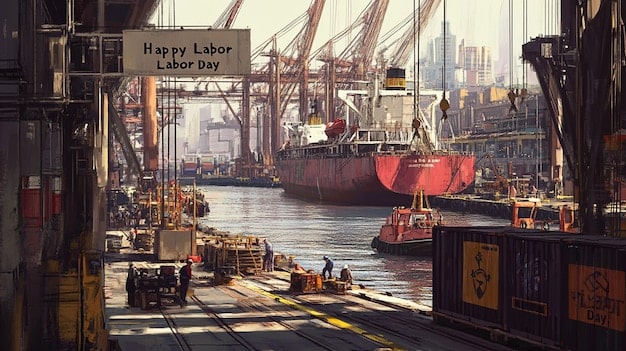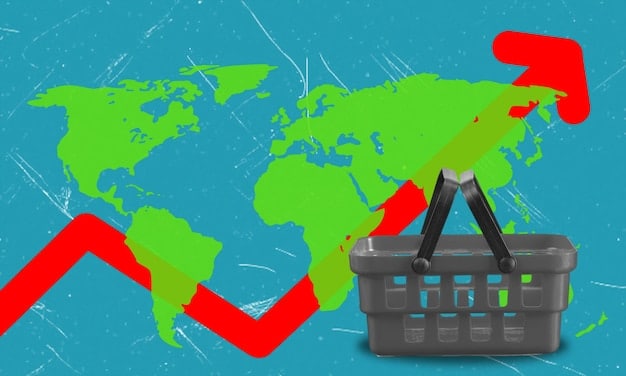Economic Impact: A Deep Dive into 15% Tariff on US Imports

The potential economic consequences of a proposed 15% tariff on imported goods for the US include increased consumer prices, reduced business investment, strained international trade relations, and potential retaliatory tariffs from other countries.
The prospect of a 15% tariff on imported goods has stirred considerable debate among economists and policymakers in the United States. Understanding the potential ramifications of such a policy is crucial for businesses, consumers, and anyone following the trajectory of the American economy. Let’s delve into the potential economic consequences of the proposed 15% tariff on imported goods.
Understanding Tariffs and Their Mechanisms
Tariffs, in essence, are taxes imposed by a government on goods and services imported from other countries. Their primary function is to increase the cost of imported products, making them relatively more expensive than domestically produced goods. This price adjustment aims to protect local industries, encourage domestic production, and generate revenue for the government. However, the implications of tariffs are far-reaching and can impact various sectors of the economy.
How Tariffs Work
Tariffs can be implemented in different forms, including:
- Ad Valorem Tariffs: These are calculated as a percentage of the imported good’s value. For example, a 15% ad valorem tariff on a $100 imported item would add $15 to its price.
- Specific Tariffs: These are fixed fees based on the quantity of the imported good, such as $1 per unit.
- Compound Tariffs: These combine both ad valorem and specific tariffs.
The effectiveness and economic impact of tariffs depend on factors like the size of the tariff, the elasticity of demand for the imported goods, and the reactions of other countries. When a tariff is imposed, it not only affects the price of the imported good but also influences the behavior of both consumers and producers.

The Rationale Behind Tariffs
Governments implement tariffs for several strategic reasons:
- Protecting Domestic Industries: Tariffs can shield local businesses from foreign competition by increasing the cost of imported goods, allowing domestic producers to gain a larger market share.
- Generating Revenue: Tariffs serve as a source of income for the government, which can be used to fund public services and reduce other taxes.
- National Security: Tariffs can be used to protect industries deemed vital for national security, ensuring a domestic supply in times of crisis.
- Trade Retaliation: Tariffs can be imposed in response to unfair trade practices by other countries, acting as a bargaining chip in international trade negotiations.
However, these benefits often come with trade-offs, including higher consumer prices, reduced choice, and potential damage to international trade relationships.
Tariffs are a complex tool with both potential benefits and drawbacks. Understanding their mechanisms and rationale is crucial for assessing the potential economic consequences of a proposed 15% tariff on imported goods.
Impact on Consumer Prices
One of the most immediate and noticeable effects of imposing a 15% tariff on imported goods is the increase in consumer prices. When tariffs raise the cost of importing products, businesses often pass these costs on to consumers in the form of higher prices. This can lead to a decrease in purchasing power, especially for households that rely heavily on imported goods.
Direct Price Increases
The most straightforward impact is that imported goods become more expensive. For example, if a product that previously cost $100 to import now faces a 15% tariff, its new cost is $115. Retailers are likely to increase the price to reflect this added expense, directly affecting consumers.
- Everyday Goods: Items like clothing, electronics, and certain food products, which are often imported, may see noticeable price increases.
- Luxury Items: High-end goods and luxury brands that are primarily imported could become significantly more expensive, potentially dampening demand.
Indirect Effects on Domestic Prices
Tariffs can also indirectly influence the prices of domestically produced goods. If imported components or raw materials become more expensive due to tariffs, domestic manufacturers may face higher production costs. These costs can then be passed on to consumers, resulting in increased prices across a broader range of products.
- Increased Production Costs: Domestic industries that rely on imported inputs may struggle with higher costs, leading to inflationary pressures.
- Reduced Competition: With fewer affordable imports, domestic producers may have less incentive to keep prices competitive, potentially leading to price increases.
The higher prices resulting from tariffs can disproportionately affect low-income households, who spend a larger percentage of their income on essential goods. This can exacerbate income inequality and reduce the overall standard of living.
The impact on consumer prices is a critical consideration when evaluating the merits of tariffs. Policymakers must weigh the potential benefits of protecting domestic industries against the risk of increasing the financial burden on consumers.

Effects on Business Investment and Growth
Beyond the immediate impact on consumer prices, a 15% tariff on imported goods can have far-reaching effects on business investment and economic growth. Increased costs and uncertainties stemming from tariffs can deter businesses from investing in new projects, expanding operations, and creating jobs. This can lead to a slowdown in economic activity and hinder long-term growth prospects.
Reduced Investment
Tariffs can create an environment of uncertainty, making businesses hesitant to commit to long-term investments. The increased cost of imported capital goods and raw materials can also reduce the profitability of new projects, further discouraging investment.
- Capital Goods: Industries that rely on imported machinery and equipment for production may postpone or cancel investments due to higher costs.
- Construction and Infrastructure: Projects that depend on imported materials like steel and cement could face delays or cost overruns.
Impact on Supply Chains
Many businesses, especially those in manufacturing and technology, rely on complex global supply chains. Tariffs can disrupt these supply chains, leading to inefficiencies, increased costs, and reduced competitiveness.
- Supply Chain Disruptions: Tariffs can force businesses to find alternative suppliers, which may be more expensive or less efficient, leading to increased production costs.
- Reduced Competitiveness: Higher production costs can make domestic businesses less competitive in international markets, reducing exports and market share.
The reduced investment and supply chain disruptions can lead to slower economic growth. Businesses may scale back hiring plans, reduce production, and postpone expansion, all of which can dampen overall economic activity.
Tariffs can have a significant adverse impact on business investment and economic growth. Policymakers need to carefully consider these potential consequences when contemplating tariff policies and strive to create a stable and predictable business environment.
International Trade Relations and Retaliation
Imposing a 15% tariff on imported goods can significantly strain international trade relations and lead to retaliatory measures from other countries. Trade is a two-way street, and when one country imposes tariffs, its trading partners often respond in kind, resulting in trade wars that harm all parties involved. Understanding the dynamics of international trade and the potential for retaliation is crucial when evaluating the impact of tariffs.
Potential for Retaliatory Tariffs
When the United States imposes tariffs on imported goods, other countries are likely to retaliate by imposing their own tariffs on US exports. This can lead to a tit-for-tat escalation of tariffs, creating a trade war.
- Reduced Exports: Retaliatory tariffs can make US goods more expensive in foreign markets, reducing exports and hurting domestic industries that rely on international sales.
- Impact on Agriculture: Agricultural products are often targeted in retaliatory tariffs, as they are politically sensitive and can have a significant impact on rural economies.
Strain on Diplomatic Relations
Trade disputes can spill over into other areas of diplomatic relations, creating tensions and undermining cooperation on other important issues.
- Erosion of Trust: Trade wars can erode trust between countries, making it more difficult to negotiate and resolve other international disputes.
- Impact on Geopolitical Stability: Trade tensions can exacerbate existing geopolitical rivalries and destabilize international relations.
The imposition of tariffs can disrupt global trade flows, leading to inefficiencies and reduced economic growth. Countries may divert trade to other partners, creating uncertainty and instability in the international trading system.
Maintaining positive international trade relations is vital for economic prosperity and global stability. Policymakers need to carefully consider the potential for retaliation and strive to resolve trade disputes through negotiation and cooperation, rather than resorting to unilateral tariffs.
Winners and Losers: A Sector-Specific Analysis
The economic consequences of a 15% tariff on imported goods are not uniform across all sectors. Some industries may benefit from reduced foreign competition, while others may suffer from increased costs and reduced export opportunities. A sector-specific analysis is essential to understanding the full impact of the proposed tariffs.
Potential Winners
- Domestic Manufacturing: Industries that compete directly with imports, such as steel, aluminum, and automobiles, may benefit from tariffs as they make imported goods more expensive, allowing domestic producers to gain market share.
- Local Agriculture: Certain agricultural sectors could see increased demand for their products if tariffs make imported food items pricier.
Potential Losers
Sectors that rely heavily on imported inputs, export goods, or have complex global supply chains may face significant challenges.
- Technology Sector: Many technology companies rely on imported components for their products. Tariffs could increase production costs and reduce competitiveness.
- Retail Sector: Retailers that sell a large volume of imported goods may see reduced sales and lower profit margins due to higher prices.
- Export-Oriented Industries: Industries that rely on exports may suffer from retaliatory tariffs imposed by other countries, reducing their sales and profitability.
Consumers across all sectors are likely to face higher prices due to the increased cost of imported goods and the knock-on effects on domestic prices. This can reduce purchasing power and lower the overall standard of living.
A comprehensive assessment of the winners and losers is crucial for evaluating the overall impact of tariffs. Policymakers need to consider the potential distributional effects and strive to mitigate the negative consequences for vulnerable sectors and consumers.
Alternatives to Tariffs
While tariffs are one policy tool for addressing trade imbalances and protecting domestic industries, several alternative approaches can achieve similar goals with potentially fewer negative consequences. Exploring these alternatives is crucial for developing a balanced and effective trade policy that promotes economic growth and prosperity.
Negotiating Trade Agreements
Bilateral and multilateral trade agreements can reduce trade barriers and promote fair trade practices. These agreements can address issues such as tariffs, quotas, and intellectual property rights, creating a more level playing field for businesses.
- Lowering Trade Barriers: Trade agreements can reduce or eliminate tariffs, making it easier for businesses to export and import goods.
- Promoting Fair Trade: Agreements can establish rules and standards to ensure fair trade practices, such as preventing dumping and protecting intellectual property rights.
Investing in Domestic Competitiveness
Rather than relying on tariffs to protect domestic industries, governments can invest in education, infrastructure, and research and development to enhance the competitiveness of local businesses.
- Education and Training: Investing in education and training programs can equip workers with the skills needed to compete in a global economy.
- Infrastructure Development: Improving infrastructure, such as roads, ports, and airports, can reduce transportation costs and improve the efficiency of supply chains.
Targeted subsidies and tax incentives can support specific industries or sectors that are facing challenges due to international competition. These measures can help businesses innovate, modernize, and become more competitive without resorting to protectionist measures.
Alternatives to tariffs can promote economic growth, create jobs, and improve the standard of living. Policymakers should carefully consider these options when developing trade policy and strive to create a balanced and effective approach that benefits all stakeholders.
| Key Aspect | Brief Description |
|---|---|
| 📈 Price Hikes | Consumers face higher prices on imported & domestic goods. |
| 📉 Investment Drop | Businesses hesitate due to economic uncertainty and rising costs. |
| ⚔️ Trade Tensions | Risk of retaliation and strained international relationships |
| 🏭 Sector Shifts | Some local industries may win; export-reliant sectors may lose. |
Frequently Asked Questions
▼
A tariff is a tax imposed by a government on goods or services imported from other countries. It increases the cost of imported products to protect domestic industries and generate revenue.
▼
Tariffs typically lead to higher prices for consumers, as businesses often pass the added costs of importing goods onto the final price of products.
▼
Yes, imposing a 15% tariff could strain trade relationships, potentially leading to retaliatory tariffs from other nations, initiating a trade dispute.
▼
Domestic manufacturing industries that compete directly with imports, like steel and auto, might benefit due to reduced foreign competition.
▼
Yes, alternatives include negotiating trade agreements to lower barriers, investing in domestic competitiveness, and offering targeted subsidies to struggling sectors.
Conclusion
In conclusion, the implementation of a 15% tariff on imported goods raises complex economic considerations. While it may offer some protection to domestic industries, the broader consequences could include higher consumer prices, reduced business investment, strained international trade relations, and the potential for retaliatory measures. Alternative policy approaches should be carefully considered to foster sustainable economic growth and maintain positive global trade dynamics.





